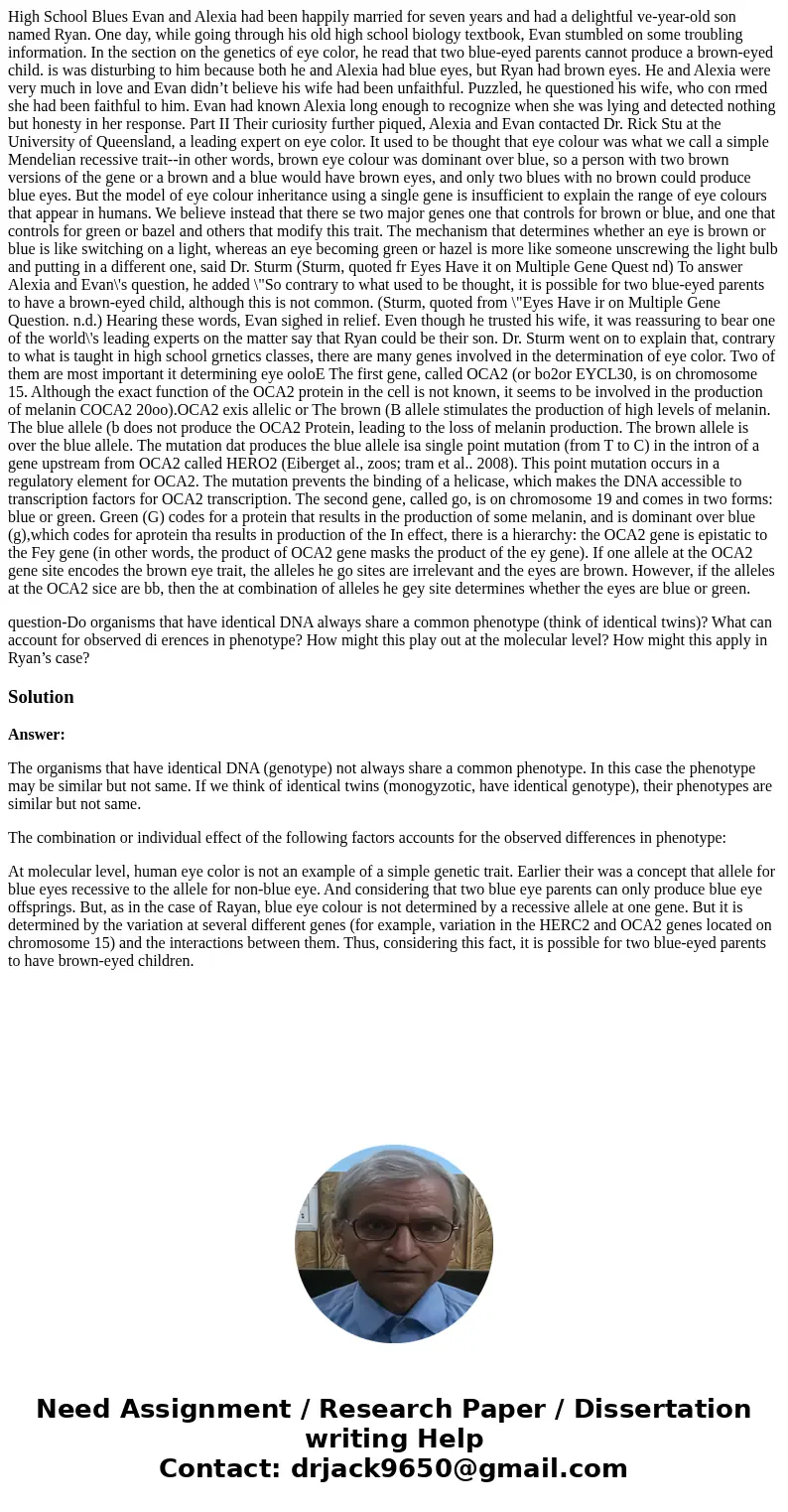High School Blues Evan and Alexia had been happily married f
High School Blues Evan and Alexia had been happily married for seven years and had a delightful ve-year-old son named Ryan. One day, while going through his old high school biology textbook, Evan stumbled on some troubling information. In the section on the genetics of eye color, he read that two blue-eyed parents cannot produce a brown-eyed child. is was disturbing to him because both he and Alexia had blue eyes, but Ryan had brown eyes. He and Alexia were very much in love and Evan didn’t believe his wife had been unfaithful. Puzzled, he questioned his wife, who con rmed she had been faithful to him. Evan had known Alexia long enough to recognize when she was lying and detected nothing but honesty in her response. Part II Their curiosity further piqued, Alexia and Evan contacted Dr. Rick Stu at the University of Queensland, a leading expert on eye color. It used to be thought that eye colour was what we call a simple Mendelian recessive trait--in other words, brown eye colour was dominant over blue, so a person with two brown versions of the gene or a brown and a blue would have brown eyes, and only two blues with no brown could produce blue eyes. But the model of eye colour inheritance using a single gene is insufficient to explain the range of eye colours that appear in humans. We believe instead that there se two major genes one that controls for brown or blue, and one that controls for green or bazel and others that modify this trait. The mechanism that determines whether an eye is brown or blue is like switching on a light, whereas an eye becoming green or hazel is more like someone unscrewing the light bulb and putting in a different one, said Dr. Sturm (Sturm, quoted fr Eyes Have it on Multiple Gene Quest nd) To answer Alexia and Evan\'s question, he added \"So contrary to what used to be thought, it is possible for two blue-eyed parents to have a brown-eyed child, although this is not common. (Sturm, quoted from \"Eyes Have ir on Multiple Gene Question. n.d.) Hearing these words, Evan sighed in relief. Even though he trusted his wife, it was reassuring to bear one of the world\'s leading experts on the matter say that Ryan could be their son. Dr. Sturm went on to explain that, contrary to what is taught in high school grnetics classes, there are many genes involved in the determination of eye color. Two of them are most important it determining eye ooloE The first gene, called OCA2 (or bo2or EYCL30, is on chromosome 15. Although the exact function of the OCA2 protein in the cell is not known, it seems to be involved in the production of melanin COCA2 20oo).OCA2 exis allelic or The brown (B allele stimulates the production of high levels of melanin. The blue allele (b does not produce the OCA2 Protein, leading to the loss of melanin production. The brown allele is over the blue allele. The mutation dat produces the blue allele isa single point mutation (from T to C) in the intron of a gene upstream from OCA2 called HERO2 (Eiberget al., zoos; tram et al.. 2008). This point mutation occurs in a regulatory element for OCA2. The mutation prevents the binding of a helicase, which makes the DNA accessible to transcription factors for OCA2 transcription. The second gene, called go, is on chromosome 19 and comes in two forms: blue or green. Green (G) codes for a protein that results in the production of some melanin, and is dominant over blue (g),which codes for aprotein tha results in production of the In effect, there is a hierarchy: the OCA2 gene is epistatic to the Fey gene (in other words, the product of OCA2 gene masks the product of the ey gene). If one allele at the OCA2 gene site encodes the brown eye trait, the alleles he go sites are irrelevant and the eyes are brown. However, if the alleles at the OCA2 sice are bb, then the at combination of alleles he gey site determines whether the eyes are blue or green.
question-Do organisms that have identical DNA always share a common phenotype (think of identical twins)? What can account for observed di erences in phenotype? How might this play out at the molecular level? How might this apply in Ryan’s case?
Solution
Answer:
The organisms that have identical DNA (genotype) not always share a common phenotype. In this case the phenotype may be similar but not same. If we think of identical twins (monogyzotic, have identical genotype), their phenotypes are similar but not same.
The combination or individual effect of the following factors accounts for the observed differences in phenotype:
At molecular level, human eye color is not an example of a simple genetic trait. Earlier their was a concept that allele for blue eyes recessive to the allele for non-blue eye. And considering that two blue eye parents can only produce blue eye offsprings. But, as in the case of Rayan, blue eye colour is not determined by a recessive allele at one gene. But it is determined by the variation at several different genes (for example, variation in the HERC2 and OCA2 genes located on chromosome 15) and the interactions between them. Thus, considering this fact, it is possible for two blue-eyed parents to have brown-eyed children.

 Homework Sourse
Homework Sourse